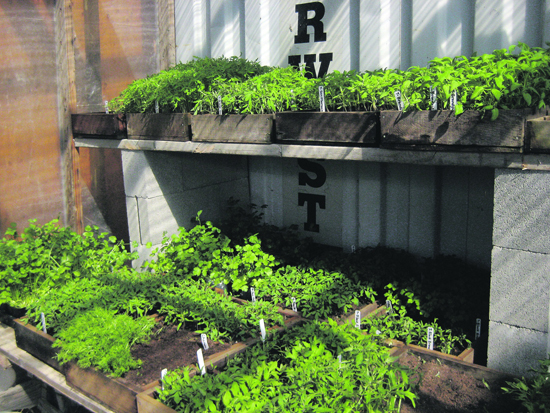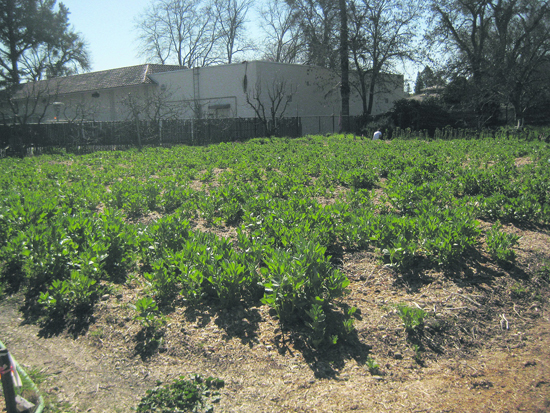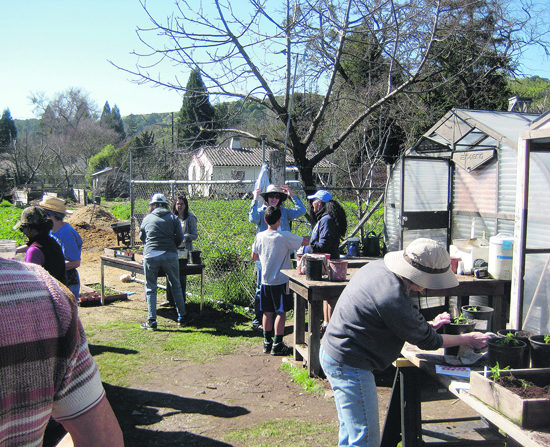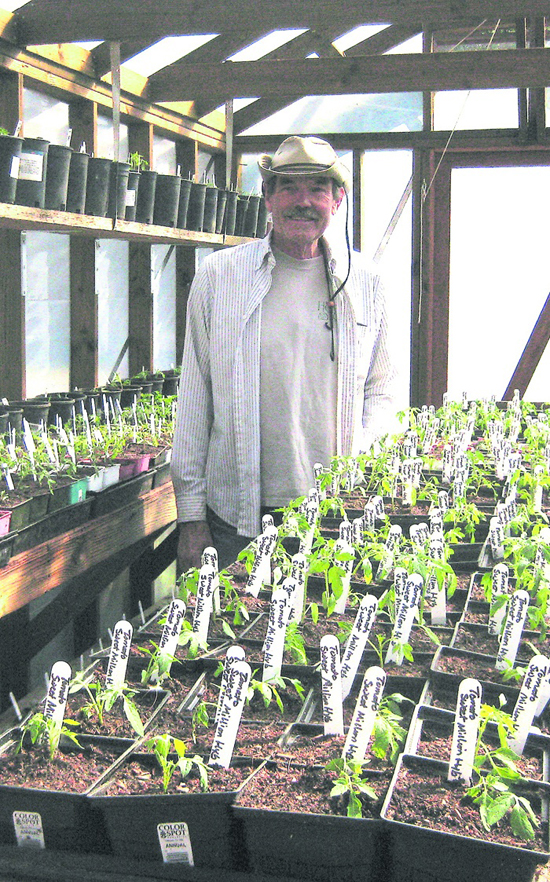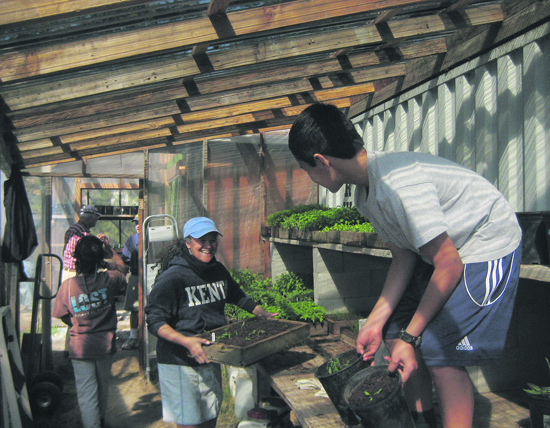 | | | Volunteers of all ages spend their Saturday morning working at the Garden Farm Photos Shophie Braccini
| | | | | | A full house of gardening enthusiasts gathered on Feb. 24 at the Moraga Library to hear experienced gardener Deva Rajan of Moraga Garden Farm and garden steward Julie Welch of Saint Mary College's Legacy Vegetable Garden discuss organic vegetable gardening.
 Rajan's and Welch's garden settings are quite different: a north facing slope for Saint Mary's, a flat rich one-acre patch of soil for the Farm. Whatever their physical setting, however, both gardeners use neither pesticides nor herbicides, and create bountiful crops utilizing ancient proven methods to grow food that can be easily replicated in local gardens.
Rajan's and Welch's garden settings are quite different: a north facing slope for Saint Mary's, a flat rich one-acre patch of soil for the Farm. Whatever their physical setting, however, both gardeners use neither pesticides nor herbicides, and create bountiful crops utilizing ancient proven methods to grow food that can be easily replicated in local gardens.
 "We are very lucky to be using a piece of land next to a creek. It used to be a garden that supplied vegetables to the Moraga Ranch in the old days of Moraga," said Rajan as he explained about the fertile soil of his property. "It belongs to the Bruzzone family, and the agreement we made with Russell (Bruzzone) dates back more than 20 years."
"We are very lucky to be using a piece of land next to a creek. It used to be a garden that supplied vegetables to the Moraga Ranch in the old days of Moraga," said Rajan as he explained about the fertile soil of his property. "It belongs to the Bruzzone family, and the agreement we made with Russell (Bruzzone) dates back more than 20 years."
 The acre is manned by a group of about 60 volunteers who take charge of the various tasks from seeding to planting, watering to weeding and harvesting. "Our philosophy is to grow more than we need, so after we sell our tomatoes and zucchini to local restaurants and markets, the volunteers get all that they need, and there is still plenty for charities." Along the way, Rajan teaches the principals of organic gardening he's learned and perfected over the years.
The acre is manned by a group of about 60 volunteers who take charge of the various tasks from seeding to planting, watering to weeding and harvesting. "Our philosophy is to grow more than we need, so after we sell our tomatoes and zucchini to local restaurants and markets, the volunteers get all that they need, and there is still plenty for charities." Along the way, Rajan teaches the principals of organic gardening he's learned and perfected over the years.
 "In the fall, we plant a cover crop of nitrogen-fixing legumes such as fava beans, bell beans and purple vetch," he said. When the plants have matured and the soil is still moist, but not too heavy, the entire cover crop is tilled into the ground. The next step is the building of four-foot-wide raised beds separated by two-foot-wide pathways.
"In the fall, we plant a cover crop of nitrogen-fixing legumes such as fava beans, bell beans and purple vetch," he said. When the plants have matured and the soil is still moist, but not too heavy, the entire cover crop is tilled into the ground. The next step is the building of four-foot-wide raised beds separated by two-foot-wide pathways.
 "We practice flood irrigation for certain crops," explained Rajan. Pathways are flooded between the raised beds where the plants are grown every two weeks. "This allows the water to saturate the bottom of the raised beds which encourages the plants to develop deeper root systems." The number one crop of the community farm for commercial sale is tomatoes. The farm cultivates nearly 850 plants, consisting of some 20 different varieties. The group gets seeds from the previous year's harvest and buys new organic heirloom seeds every year to test what works best in Moraga. All plants are started from seeds in January in one of the four green houses.
"We practice flood irrigation for certain crops," explained Rajan. Pathways are flooded between the raised beds where the plants are grown every two weeks. "This allows the water to saturate the bottom of the raised beds which encourages the plants to develop deeper root systems." The number one crop of the community farm for commercial sale is tomatoes. The farm cultivates nearly 850 plants, consisting of some 20 different varieties. The group gets seeds from the previous year's harvest and buys new organic heirloom seeds every year to test what works best in Moraga. All plants are started from seeds in January in one of the four green houses.
 "We plant our tomatoes after the last frost, usually around mid-April," Rajan said. Volunteers dig deep holes where one shovel-full of compost is thrown, with the addition of a handful of chicken manure. Water is added, and after mixing, the tomato is planted deep into the soil.
"We plant our tomatoes after the last frost, usually around mid-April," Rajan said. Volunteers dig deep holes where one shovel-full of compost is thrown, with the addition of a handful of chicken manure. Water is added, and after mixing, the tomato is planted deep into the soil.
 Rice straw is spread generously around the plants as a mulch to retain moisture and to control the weeds. This also keeps the soil populations of worms and micro-organisms high. Since no herbicides are used, volunteers take charge of weeding when needed.
Rice straw is spread generously around the plants as a mulch to retain moisture and to control the weeds. This also keeps the soil populations of worms and micro-organisms high. Since no herbicides are used, volunteers take charge of weeding when needed.
 "Once the plants are at full height we stop watering," Rajan said. "It gives the signal to the plant it is time to set and grow fruits." The plants will be watered again if they start giving signs of over-stressing, such as leaves starting to curl.
"Once the plants are at full height we stop watering," Rajan said. "It gives the signal to the plant it is time to set and grow fruits." The plants will be watered again if they start giving signs of over-stressing, such as leaves starting to curl.
 To fight pests, the most efficient remedy Rajan has found is planting Marigolds at the end of each row of tomatoes. "They work as a natural bug repellent by attracting beneficial insects such as lady bugs," he said. The same principals of using compost, mulch and quite a lot of manual work are also applied by Welch at Saint Mary's.
To fight pests, the most efficient remedy Rajan has found is planting Marigolds at the end of each row of tomatoes. "They work as a natural bug repellent by attracting beneficial insects such as lady bugs," he said. The same principals of using compost, mulch and quite a lot of manual work are also applied by Welch at Saint Mary's.
 The Legacy Garden was built and planted from scratch by the class of 2012, four years ago. "We used old bleachers to build our raised beds," she explained. The hillside that was given for the garden is typical Moraga hard clay, the type that needs a lot of amendment to become fertile ground for veggies. Building the beds and adding organic dirt was the solution.
The Legacy Garden was built and planted from scratch by the class of 2012, four years ago. "We used old bleachers to build our raised beds," she explained. The hillside that was given for the garden is typical Moraga hard clay, the type that needs a lot of amendment to become fertile ground for veggies. Building the beds and adding organic dirt was the solution.
 "We compost the vegetables left over from the campus' restaurant, mixed with the leaves," Welch said. "We also do worm composting." Plenty of students provide the manpower to tend the college's organic garden, and there are plenty of participants, too, when picnics are organized in the garden at harvest time. "We also provide a lot of greens to the campus salad bar," she added.
"We compost the vegetables left over from the campus' restaurant, mixed with the leaves," Welch said. "We also do worm composting." Plenty of students provide the manpower to tend the college's organic garden, and there are plenty of participants, too, when picnics are organized in the garden at harvest time. "We also provide a lot of greens to the campus salad bar," she added.
 Both Welch and Rajan referenced Ken Murakami, owner of Moraga Garden Center, as a great source of information, support and supplies. For those who plan to start an organic garden this spring, Moraga Gardens Farm will sell about 2,500 rare-to-find heirloom plants this season. In addition to tomatoes, the group will have herbs, eggplants, artichokes, peppers and chayotes. Their sale dates are March 25, April 7, 8 , 14, 15, 21, and 22, from 9 a.m. to 1 p.m., 1370 Moraga Way, Moraga (between the fire station and School Street).
Both Welch and Rajan referenced Ken Murakami, owner of Moraga Garden Center, as a great source of information, support and supplies. For those who plan to start an organic garden this spring, Moraga Gardens Farm will sell about 2,500 rare-to-find heirloom plants this season. In addition to tomatoes, the group will have herbs, eggplants, artichokes, peppers and chayotes. Their sale dates are March 25, April 7, 8 , 14, 15, 21, and 22, from 9 a.m. to 1 p.m., 1370 Moraga Way, Moraga (between the fire station and School Street).

|

